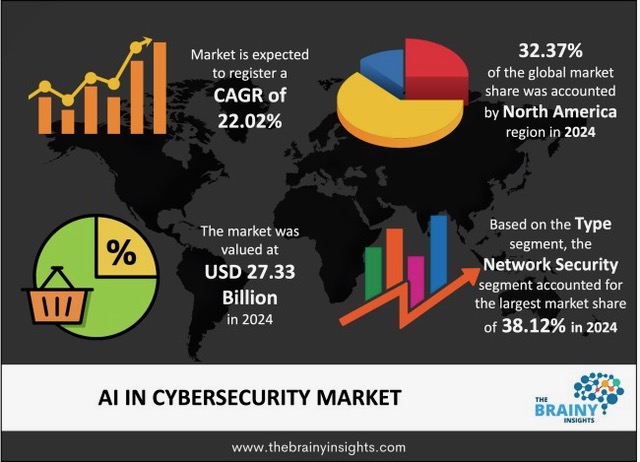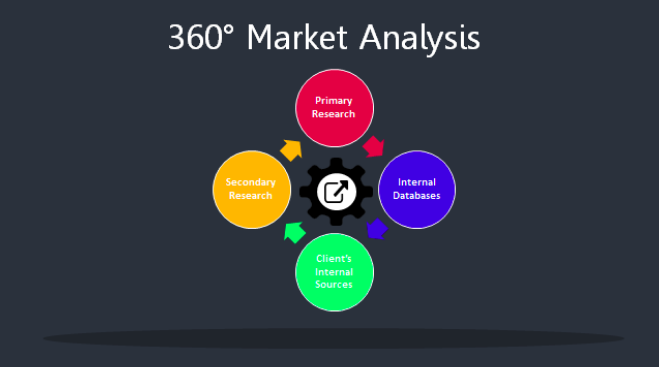- +1-315-215-1633
- sales@thebrainyinsights.com

The global AI In Cybersecurity market was valued at USD 27.33 Billion in 2024 and grew at a CAGR of 22.02% from 2025 to 2034. The market is expected to reach USD 200.01 Billion by 2034. The market is driven by the surge in threats from hackers and cyberattacks fueled by technological progress. The application of Artificial Intelligence (AI) in cybersecurity is transforming the dynamics of how organizations protect themselves from cyber threats. It typically employs sophisticated machine learning (ML) algorithms to analyze large volumes of risk data from various sources, identifying patterns that indicate potential threats and enabling swift responses to emerging risks. AI helps identify anomalies and then mitigates threats in the IT infrastructure with speed and accuracy. It thus strengthens the organization’s complete cybersecurity infrastructure. AI in cybersecurity is still in its early stages, but it is growing significantly.
AI-powered cybersecurity identifies anomalies and employs behavioural analysis methods to detect suspicious activities and any abnormalities in behaviour. AI cybersecurity solutions continuously respond to evolving threats in real time; thus, they deliver an automated response mechanism, which leads to fast response times and a reduction in potential damages. Moreover, AI cybersecurity also decreases human intervention with the use of automation. Advanced algorithms reduce the false positive rates, which improves the threat detection accuracy. Additionally, AI cybersecurity solutions possess excellent predictive capabilities, utilizing data analytics to prepare for and take proactive steps against various potential threats. AI is making a significant impact on cybersecurity by helping to quickly and accurately recognize patterns, threats, and irregularities. It also facilitates continuous monitoring of enterprise networks for vulnerabilities and responds to threats accordingly. Its proactive stance in threat management led to a reduction in human intervention and accelerated the recovery time. AI accelerates the analysis of large datasets to identify any type of anomalies, vulnerabilities, and risks that may occur, including advanced threats such as polymorphic malware and living off the land (LOTL) attacks. For instance, Polymorphic malware is a type of virus that changes its appearance to evade conventional cybersecurity solutions, and LOTL attacks utilize legitimate tools within the system to perform malicious activities. AI precisely identifies the actual attacks, which is unlike conventional cybersecurity tools. Hence, AI reduces false positives and determines responses based on real-world risks.
The significant growth of AI in the cybersecurity market has led to its tremendous use in threat detection. Innovative AI-powered security monitoring tools are being utilized to combat sophisticated cyber threats, thereby transforming the way organizations must protect their digital infrastructure. AI-driven cybersecurity innovates and revolutionizes the business approach to digital protection, helping mitigate risks and protect sensitive data. Cybersecurity can utilize AI in several ways, thereby transforming reactive systems into proactive ones.

Get an overview of this study by requesting a free sample
The surge in cybercrimes– There is an advancement in technology happening, and it has led to a surge in threats from hackers and cyberattacks. Cybercrimes, such as scams, phishing, and data theft, have increased, putting organisations at risk. To combat such threats, organisations are focusing on qualified cybersecurity teams that utilise cutting-edge technologies, such as AI, which can swiftly detect and counter malicious activities, thereby improving the network's resilience against threats. The potential of AI has driven around 76% of organisations to focus on AI and machine learning, prioritising it in their IT budgets, as a large volume of data requires analysis for the effective identification and combat of security threats. As the connected device is estimated to generate around 79 zettabytes of data by 2025, human manual analysis would become impossible, thus making AI a crucial tool in the fight against cybercrime. These factors are eventually propelling the growth of AI in the cybersecurity market.
Data Privacy – There are several factors that hinder market growth, including data privacy concerns, complexities in integrating AI solutions, high implementation costs, and the need for highly skilled professionals. Also, there is a risk of counter-AI attacks, which can target security systems. All these factors are acting as restraints for the market.
Focus on Modern security threats – The surge in the frequency of cyberattacks has led to the rapid adoption of AI in cybersecurity. According to one study, approximately 48.9% of world executives and security experts consider AI and machine learning to be important tools for combating modern security threats. Additionally, another report suggests that around 44% of global organisations already utilise AI for detecting security interruptions. AI in cybersecurity helps maintain secure applications by eliminating the vulnerability for users. It helps in the eradication of negative defaults and guarantees precision in identifying issues, speeding up investigations and automating response mechanisms. AI-driven solutions, such as user verification, foster secure app development, and behavioural biometrics offer a safe data ecosystem, which leads to a robust infrastructure. AI can help identify potential malicious activities and threat actors, allowing organisations to predict and prevent cyberattacks before they occur. AI-enabled automated monitoring helps safeguard the system around the clock, allowing organisations to take proactive measures to protect their digital assets before any harm is done. All these factors are increasing the demand for the use of AI In Cybersecurity in the forecasting period.
The regions analysed for the market include North America, Europe, South America, Asia Pacific, the Middle East, and Africa. North America emerged as the most significant global AI In Cybersecurity market, with a 32.37% market revenue share in 2024.
The North American region leads the AI in the Cybersecurity market due to the US's advanced technological infrastructure and its high adoption by numerous organisations across various sectors in the region. Moreover, regulatory frameworks are also boosting the use of the most advanced cybersecurity measures. Additionally, the region is a major hub for leading high-tech organisations and research institutions. These factors will eventually create a high demand for AI In Cybersecurity in the region.
North America Region AI In Cybersecurity Market Share in 2024 – 32.37%
www.thebrainyinsights.com
Check the geographical analysis of this market by requesting a free sample
The type segment is divided into network security, endpoint security and application security and hardware security. Network security segment dominated the market, with a market share of around 38.12% in 2024. This significant share is attributed to its crucial capability in protecting the organization’s infrastructure. Several solutions, such as virtual private networks, intrusion detection systems, and firewalls, are helping to safeguard networked environments. Organizations are utilizing these technologies to prevent unauthorized access, secure endpoints, and mitigate risks associated with potential threats.
The offerings segment is divided into hardware, software and services. The services segment dominated the market, with a market share of around 36.43% in 2024. This significant share is due to the growing demand for the deployment of AI-driven security solutions. These advanced AI-driven security services provide advanced threat detection, continuous monitoring, and a tailored response tailored to the organization's unique requirements. Leading organizations prefer these services to avoid the complexity of in-house AI expertise. These AI tools are seamlessly integrated into the organizational security framework, which helps in the enhancement of efficiency and reduction of disruption.
| Attribute | Description |
|---|---|
| Market Size | Revenue (USD Billion) |
| Market size value in 2024 | USD 27.33 Billion |
| Market size value in 2034 | USD 200.01 Billion |
| CAGR (2025 to 2034) | 22.02% |
| Historical data | 2021-2023 |
| Base Year | 2024 |
| Forecast | 2025-2034 |
| Region | The regions analyzed for the market are Asia Pacific, Europe, South America, North America, and Middle East and Africa. Furthermore, the regions are further analyzed at the country level. |
| Segments | Type and Offerings |
As per The Brainy Insights, the size of the global AI In Cybersecurity market was valued at USD 27.33 billion in 2024 to USD 200.01 billion by 2034.
Global AI In Cybersecurity market is growing at a CAGR of 22.02% during the forecast period 2025-2034.
The market's growth will be influenced by the surge in cybercrimes.
Data privacy could hamper the market growth.
This study forecasts revenue at global, regional, and country levels from 2021 to 2034. The Brainy Insights has segmented the global AI In Cybersecurity market based on below mentioned segments:
Global AI In Cybersecurity Market by Type:
Global AI In Cybersecurity Market by Offerings:
Global AI In Cybersecurity Market by Region:
Research has its special purpose to undertake marketing efficiently. In this competitive scenario, businesses need information across all industry verticals; the information about customer wants, market demand, competition, industry trends, distribution channels etc. This information needs to be updated regularly because businesses operate in a dynamic environment. Our organization, The Brainy Insights incorporates scientific and systematic research procedures in order to get proper market insights and industry analysis for overall business success. The analysis consists of studying the market from a miniscule level wherein we implement statistical tools which helps us in examining the data with accuracy and precision.
Our research reports feature both; quantitative and qualitative aspects for any market. Qualitative information for any market research process are fundamental because they reveal the customer needs and wants, usage and consumption for any product/service related to a specific industry. This in turn aids the marketers/investors in knowing certain perceptions of the customers. Qualitative research can enlighten about the different product concepts and designs along with unique service offering that in turn, helps define marketing problems and generate opportunities. On the other hand, quantitative research engages with the data collection process through interviews, e-mail interactions, surveys and pilot studies. Quantitative aspects for the market research are useful to validate the hypotheses generated during qualitative research method, explore empirical patterns in the data with the help of statistical tools, and finally make the market estimations.
The Brainy Insights offers comprehensive research and analysis, based on a wide assortment of factual insights gained through interviews with CXOs and global experts and secondary data from reliable sources. Our analysts and industry specialist assume vital roles in building up statistical tools and analysis models, which are used to analyse the data and arrive at accurate insights with exceedingly informative research discoveries. The data provided by our organization have proven precious to a diverse range of companies, facilitating them to address issues such as determining which products/services are the most appealing, whether or not customers use the product in the manner anticipated, the purchasing intentions of the market and many others.
Our research methodology encompasses an idyllic combination of primary and secondary initiatives. Key phases involved in this process are listed below:

The phase involves the gathering and collecting of market data and its related information with the help of different sources & research procedures.

The data procurement stage involves in data gathering and collecting through various data sources.
This stage involves in extensive research. These data sources includes:
Purchased Database: Purchased databases play a crucial role in estimating the market sizes irrespective of the domain. Our purchased database includes:
Primary Research: The Brainy Insights interacts with leading companies and experts of the concerned domain to develop the analyst team’s market understanding and expertise. It improves and substantiates every single data presented in the market reports. Primary research mainly involves in telephonic interviews, E-mail interactions and face-to-face interviews with the raw material providers, manufacturers/producers, distributors, & independent consultants. The interviews that we conduct provides valuable data on market size and industry growth trends prevailing in the market. Our organization also conducts surveys with the various industry experts in order to gain overall insights of the industry/market. For instance, in healthcare industry we conduct surveys with the pharmacists, doctors, surgeons and nurses in order to gain insights and key information of a medical product/device/equipment which the customers are going to usage. Surveys are conducted in the form of questionnaire designed by our own analyst team. Surveys plays an important role in primary research because surveys helps us to identify the key target audiences of the market. Additionally, surveys helps to identify the key target audience engaged with the market. Our survey team conducts the survey by targeting the key audience, thus gaining insights from them. Based on the perspectives of the customers, this information is utilized to formulate market strategies. Moreover, market surveys helps us to understand the current competitive situation of the industry. To be precise, our survey process typically involve with the 360 analysis of the market. This analytical process begins by identifying the prospective customers for a product or service related to the market/industry to obtain data on how a product/service could fit into customers’ lives.

Secondary Research: The secondary data sources includes information published by the on-profit organizations such as World bank, WHO, company fillings, investor presentations, annual reports, national government documents, statistical databases, blogs, articles, white papers and others. From the annual report, we analyse a company’s revenue to understand the key segment and market share of that organization in a particular region. We analyse the company websites and adopt the product mapping technique which is important for deriving the segment revenue. In the product mapping method, we select and categorize the products offered by the companies catering to domain specific market, deduce the product revenue for each of the companies so as to get overall estimation of the market size. We also source data and analyses trends based on information received from supply side and demand side intermediaries in the value chain. The supply side denotes the data gathered from supplier, distributor, wholesaler and the demand side illustrates the data gathered from the end customers for respective market domain.

The supply side for a domain specific market is analysed by:
The demand side for the market is estimated through:
In-house Library: Apart from these third-party sources, we have our in-house library of qualitative and quantitative information. Our in-house database includes market data for various industry and domains. These data are updated on regular basis as per the changing market scenario. Our library includes, historic databases, internal audit reports and archives.
Sometimes there are instances where there is no metadata or raw data available for any domain specific market. For those cases, we use our expertise to forecast and estimate the market size in order to generate comprehensive data sets. Our analyst team adopt a robust research technique in order to produce the estimates:
Data Synthesis: This stage involves the analysis & mapping of all the information obtained from the previous step. It also involves in scrutinizing the data for any discrepancy observed while data gathering related to the market. The data is collected with consideration to the heterogeneity of sources. Robust scientific techniques are in place for synthesizing disparate data sets and provide the essential contextual information that can orient market strategies. The Brainy Insights has extensive experience in data synthesis where the data passes through various stages:


Market Deduction & Formulation: The final stage comprises of assigning data points at appropriate market spaces so as to deduce feasible conclusions. Analyst perspective & subject matter expert based holistic form of market sizing coupled with industry analysis also plays a crucial role in this stage.
This stage involves in finalization of the market size and numbers that we have collected from data integration step. With data interpolation, it is made sure that there is no gap in the market data. Successful trend analysis is done by our analysts using extrapolation techniques, which provide the best possible forecasts for the market.
Data Validation & Market Feedback: Validation is the most important step in the process. Validation & re-validation via an intricately designed process helps us finalize data-points to be used for final calculations.

The Brainy Insights interacts with leading companies and experts of the concerned domain to develop the analyst team’s market understanding and expertise. It improves and substantiates every single data presented in the market reports. The data validation interview and discussion panels are typically composed of the most experienced industry members. The participants include, however, are not limited to:
Moreover, we always validate our data and findings through primary respondents from all the major regions we are working on.
Free Customization
Fortune 500 Clients
Free Yearly Update On Purchase Of Multi/Corporate License
Companies Served Till Date